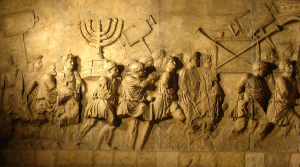The Emblem of the State of Israel
Do you know what the Emblem of the State of Israel is? We all know the flag – but are we aware of the Emblem? It actually has a strong Channuka connection. It is the Menorah, the seven branched candelabra that stood in the Temple and was lit by the Cohanim there. In 1948, not long after the founding of the State of Israel, a committee was set up to decide on an Emblem. The majority suggestion was the Menorah, and here is the final decision in 1949 as to the Emblem, still in use today:

The Emblem was of course based on the Menorah in the Tabernacle and Temple. But although we knew that it had seven branches, three to each side and a straight middle one; were we aware of the form of the base of the Menorah? The Talmud discusses the shape of the Menorah and its measurements, and mentions that it has ‘legs’ without mentioning how many. It was assumed that the Menorah had three legs, in other words a tripod base. In fact many archaeological finds of Menorah inscriptions and mosaics, for instance in Bet Shaarim showed Menorahs with tripod bases.
Here is an example:
 But the design most preferred and chose for the Emblem of Israel, rather than using the Tripod base, used two octagonal podiums, one larger underneath one smaller. And this design came from a piece of incredible design history – the Arch of Titus just outside Rome. It was a victory Arch built by the then Roman Emperor Domitian around 80 CE in honour of the victories of his brother Titus in Judea. In one place on the Arch, clearly pictured are Roman soldiers taking away the spoils of the Temple and Jewish captives. The Menorah is clearly spotted being carried, and it has octagonal bases. The symbolism was clear. This was how the exile had begun. We can now say with the creation of Israel, that the exile had ended. We had come full circle. Here is the small part of the Arch of Titus showing the Menorah with octagonal bases:
But the design most preferred and chose for the Emblem of Israel, rather than using the Tripod base, used two octagonal podiums, one larger underneath one smaller. And this design came from a piece of incredible design history – the Arch of Titus just outside Rome. It was a victory Arch built by the then Roman Emperor Domitian around 80 CE in honour of the victories of his brother Titus in Judea. In one place on the Arch, clearly pictured are Roman soldiers taking away the spoils of the Temple and Jewish captives. The Menorah is clearly spotted being carried, and it has octagonal bases. The symbolism was clear. This was how the exile had begun. We can now say with the creation of Israel, that the exile had ended. We had come full circle. Here is the small part of the Arch of Titus showing the Menorah with octagonal bases:
 Plenty has been written as to how the changes were introduced into the Menorah from the traditional model. The model in Titus’s arch would not curiously be a kosher model for use in the Temple.
Plenty has been written as to how the changes were introduced into the Menorah from the traditional model. The model in Titus’s arch would not curiously be a kosher model for use in the Temple.
And so it is fascinating, as a member of my Shul mentioned to me in Kiddush last Shabbat, that the Emblem of Israel is based on the design that derives from Roman art, not from the traditional design. Furthermore, as I mentioned in my sermon last Shabbat, it is not clear that we can look at the birth of the State of Israel as the end of exile. It is a return. For many religious Jews it is testimony, and the life of our modern State has been testimony to the close involvement of G-d in our history. But it is not the end. It may be the beginning of a process that leads to the end – and even that needs to be thought out carefully.
But the symbolism of the Arch of Titus and the Menorah which figures in the Emblem is still powerful. I read that when Israel’s independence was announced, many Jews living in Rome converged on the Arch of Titus, and men, women and children, the young and the old walked backwards through the Arch as if to symbolically undo its meaning. Powerful indeed!
